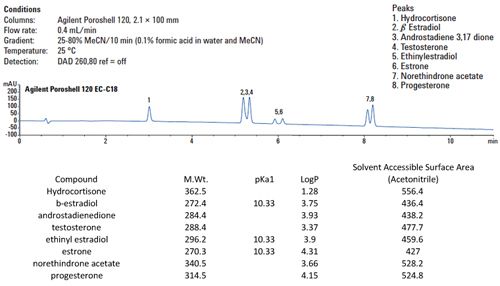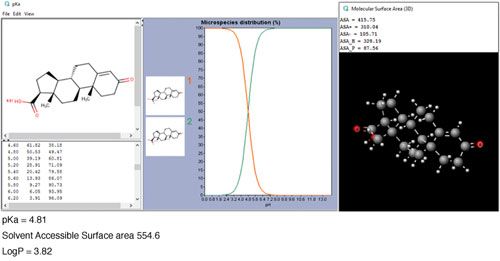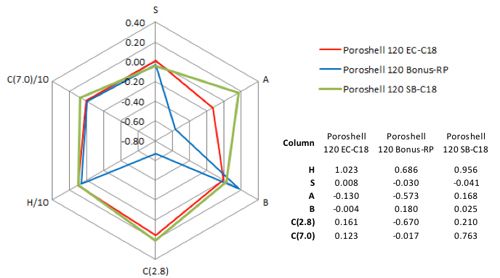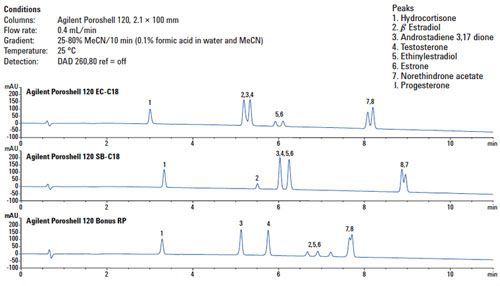Useful Free Tools for HPLC Method Development
I’ve done that thing where I’ve stated a very interesting title-I hope I can deliver something which lives up to it. I dislike it when people “overstate” their talk or poster titles at conferences to draw me in and then don’t deliver against the promise-I’ll let you judge how we go here.
I’ve done that thing where I’ve stated a very interesting title-I hope I can deliver something which lives up to it. I dislike it when people “overstate” their talk or poster titles at conferences to draw me in and then don’t deliver against the promise-I’ll let you judge how we go here.
I was investigating a separation that I was adapting from a manufacturer's application note (1) and wanted to check the effects we were seeing on changing column selectivity.
Here are the analytes and the separation on an Agilent Poroshell C18-EC (end-capped) column and the associated separation of a bunch of steroids that we have been working on.

CLICK FIGURE TO ENLARGE
So I wanted to check the elution order and how this correlated with the hydrophobicity of the analytes and if any other factors were dictating retention and selectivity on this “standard” end capped octadecylsilyl column.
When I started my career some 30 years ago, this would have meant a good chunk of time spent with the Handbook of Chemistry and Physics (2) in the hope that I could find all of the relevant analytes. Of course these days it’s possible to find most physicochemical information on-line, but I wanted to highlight one site that is highly useful for those of us involved in HPLC analysis-just in case you haven’t come across it yet. The site is called Chemicalize and it was developed and is maintained by CHEMAXON (www.chemicalize.org) and contains most of the useful measurements that we need to help us understand analyte behavior of a wealth of common, and some not so common, species. I’ve shown a screen shot for the search on estrone in Figure 2.

CLICK FIGURE TO ENLARGE
I’ve only shown a limited amount of information available from the site in Figure 2 as this is what was required for my particular application but I’d encourage you to explore all of the other useful information for yourself. It is certainly very easy to obtain information on hydrophobicity (LogP & LogD) as well as pKa, molecular weight, molecular geometry, polar nature, surface area, and other very useful data.
Figure 3 shows the C18 separation again tabulated in elution order against the physicochemical parameters that are thought to affect this separation.

CLICK FIGURE TO ENLARGE
As you will see, in the most part, the elution order increases with increasing hydrophobicity (increasing values of LogP, the octanol/water partition co-efficient) as one might expect in reversed phase chromatography, however, where this trend is not followed (by testosterone for example) the later than expected elution can be explained by an increase in accessible acetonitrile solute surface area-which again is a very useful predictor of retention in reversed phase HPLC and represents the relative area available for the solvent or the stationary phase to interact with.
Before moving on to investigate the selectivity options from other phases, I wanted to predict the retention time of an analyte which is an acid analogue of the androstadienedione molecule. Unfortunately this analyte is not contained within the Chemicalize database, however, never fear because ChemAxon also offer another free resource called MarvinSketch (https://www.chemaxon.com/products/marvin/marvinsketch), which is a chemical structures drawing program containing some free plug-ins that can estimate/calculate the same physicochemical parameters which we’ve used to analyze the separation so far. After drawing the acid analogue, the plug-ins were used to predict the physicochemical data which is shown in Figure 4.

CLICK FIGURE TO ENLARGE
We didn’t have the analogue synthesized at the time of doing this predictive work, however, we could estimate that the analyte may elute in the fairly “crowded” area around peaks two and three. So how do we select columns in order to try and improve the separation between these closely eluting analytes as well as improving the separation between already co-eluting peak pairs? Are there any tools available which will allow us to predict the type of phase that we might want to use?
There are several models for describing stationary phase selectivity which I’ve discussed previously (http://www.chromatographyonline.com/column-selection-hplc-method-development) so I won’t cover the basics here – except to say that knowing something of the selectivity characteristics of the columns you wish to consider for the analysis is immensely helpful. The next really useful tool then, is the database of column selectivity which is maintained by Dwight Stolls’ group at Gustavus Adolphus College and which can be found atwww.HPLCcolumns.org and a selective screenshot is shown in Figure 5.

CLICK FIGURE TO ENLARGE
You will see that the database characterizes the columns as per the parameters described in the hydrophobic subtraction model (HSM) (3). This database is very useful for finding the HSM data on just about every reversed phase column in existence, as well as looking for similar and orthogonal column chemistries and highlighting columns which have dominant characteristics for the retention and separation of target analytes.
So putting the database above to use, I looked for two columns that I thought might give some different characteristics to those of the C18 we started with. The results of my findings are shown in Figure 6. The Excel spreadsheet radar plot output is from a tool that we created at Crawford Scientific, however it’s very simple to make something similar.

CLICK FIGURE TO ENLARGE
Before I go further, I should point out that this is unweighted data, and one needs to weight the data for the various analyte characteristics, which can be very usefully done using the database at www.HPLCcolumns.org. Secondly-I’m in no way claiming that we can do any sort of quantitative structure/activity correlation with the tools that I’m discussing here. For that type of development, you should be following the work of Paul Haddads’ group at the University of Tasmania and their various collaborators. I’ve cited one paper in Reference 4 for you to start from.
However, it is useful to begin to relate the selectivity properties of the columns to what “might” and what “does” happen in practice, or even to select columns based on what interactions you THINK might be dominant in the analyte / stationary phase interaction. In this way our column selection and method optimization can be much better informed.
Again without going into too much detail-we can relate the results from the databases with the stationary phase characteristics to postulate what might happen when various phases are used-here we picked a non-endcapped phase which is sterically protected with bulky iso-butyl substituent groups on the bonded ligand, as well as a polar embedded column which typically contain a carbamate or imide functional group within the alkyl chain.
Note that the structures shown in Figure 7 are representative of the “type” of ligand used and do not represent that actual chemistry of these phases. Further, we’ve represented the chain lengths on each ligand in a rather unconventional way for convenience and “space!”

CLICK FIGURE TO ENLARGE
So, what differences in the separation can we expect from these alternative phases, given the data from the column selectivity database?
The StableBond (SB C18) column will give approximately the same hydrophobic retention but will show increased shape selectivity. This will result in increased retention for sterically more bulky and less polar analytes. It can be expected that more polar or ionogenic analytes will not show the same extended retention.
It’s important to note that the StableBond column is non-endcapped, and had the separation been carried out at pH values above 6, the selectivity might have looked very different as the acidic surface silanol groups become ionized (pka is around 4) and the polarity of the surface changes markedly, becoming increasingly anionic, which is reflected in the large value for the ion exchange capacity at pH 7.0 (C7.0). However, the eluent for this experiment was pH 2.8 (approx.) after adjustment with 0.1% formic acid and as such we expect any acidic silanol groups to be non-ionized, and therefore, have less effect on the separation.
Figure 6 indicates that the polar embedded Bonus RP column will show much greater retention of acidic species due to interaction with the embedded basic group in the ligand, and much lower retention of basic species, as any exposed surface silanol groups are “shielded” by the embedded polar ligand. In general the hydrophobic retention of this column is lower, so any less polar compounds should show shortened retention times.
The actual chromatograms obtained are shown in Figure 8, alongside the original chromatogram from the end-capped C18.

CLICK FIGURE TO ENLARGE
Without undergoing an in-depth debrief on the results, it can be seen that the SB-C18 does indeed show extended retention for the less polar analytes and those without a polar or ionizable functional group are effectively retained to a lower degree which is entirely in keeping with an increase in the shape selectivity of the phase. Compounds 2, 5 and 6, which are very weakly acidic, are effected less markedly.
The Bonus RP column shows reduced retention of the non-polar compounds and a markedly higher retention of the acidic compounds (2, 5, and 6) as predicted. This separation certainly gives a much better opportunity to “insert” the acidic androstadienedione analogue which will hopefully elute just before or after compounds 7 and 8.
While the separation was still not optimized, a successful separation was eventually affected using a phenyl hexyl functional column with methanol as the eluent modifier. My point here is that there are a host of tools available to help guide our HPLC method development and optimization choices and we should all be taking full advantage of them!
I also appreciate that I’ve highlighted only a limited set of tools here and readers and vendors alike will be keen to let me know of their versions of these tools or other tools that can be used.
References
- “Fast Screening Methods for Steroids by HPLC with Agilent Poroshell 120 Columns,” Agilent Application note 5991–0451.
- CRC Handbook of Chemistry and Physics, 96th Edition, W.M. Haynes, Ed., (CRC Press, Boca Raton, 2015).
- N.S. Wilson, M.D. Nelson, J.W. Dolan, L.R. Snyder, R.G. Wolcott, and P.W. Carr, J. Chromatogr. A961, 195–215 (2002).
- M. Talebi, G. Schuster, R.A. Shellie, R. Szucs, and P.R. Haddad, J. Chromatogr. A 1424, 69–76 (2015).

Tony Taylor is the technical director of Crawford Scientific and ChromAcademy. He comes from a pharmaceutical background and has many years of research and development experience in small molecule analysis and bioanalysis using LC, GC, and hyphenated MS techniques. Taylor is actively involved in method development within the analytical services laboratory at Crawford Scientific and continues to conduct research in LC-MS and GC-MS methods for structural characterization. As the technical director of the ChromAcademy, Taylor has spent the past 12 years as a trainer and developing online education materials in analytical chemistry techniques.
The LCGC Blog: Historical (Analytical) Chemistry Landmarks
November 1st 2024The American Chemical Society’s National Historic Chemical Landmarks program highlights sites and people that are important to the field of chemistry. How are analytical chemistry and separation science recognized within this program?
